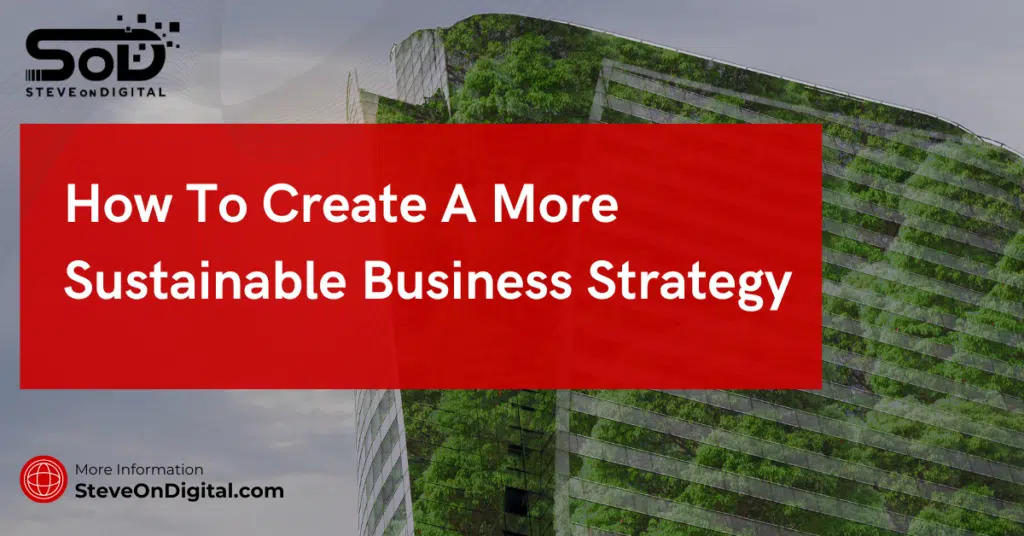How To Create A More Sustainable Business Strategy | Comprehensive Guide

As a Digital Transformation Specialist and the voice behind SteveOnDigital, I’ve dedicated my career to steering small and medium-sized enterprises (SMEs) towards digital and sustainable success. With my expertise rooted in electrical engineering and expanded through an MBA and a master’s in Project Management, I understand deeply how crucial a sustainable business strategy is not just for compliance, but for thriving in today’s fast-paced market. My approach is hands-on, drawing from a rich blend of industry knowledge and personal commitment to family, sports, and continuous education. Today, I’m sharing insights on how to craft a more sustainable business strategy that ensures long-term success while positively impacting our community and planet. This isn’t just business—it’s about building a legacy that respects both the earth and its inhabitants. Introduction To Sustainable Business Strategies When I first ventured into the digital landscape with SteveOnDigital, I realized that the core of enduring success was sustainability—not just in terms of content but in every aspect of business. Today, I’m diving deep into why creating a more sustainable business strategy is not just a good-to-have, but a must-have in today’s business environment. Sustainability in business goes beyond green practices; it’s about designing operations that can thrive over the long term without depleting the resources or harming the society on which they depend. It’s about building a business that not only grows but improves the fabric of the community and protects the environment. Integrating sustainable practices is not just beneficial for the environment but is also a key driver of business success, ensuring that sustainability is connected to business success in any sustainability strategy development. As a business owner, my goal is to integrate sustainable practices that align closely with both business needs and environmental stewardship. Understanding The Foundations Of Sustainability Understanding the strategic aspect of a business sustainability strategy can transform the way you operate and how you are perceived in the market, emphasizing the importance of executive leadership in driving purpose-driven and authentic leadership from across the organization. Definition And Principles Of Sustainability A sustainable business strategy is one that fosters business growth while positively managing the company’s impact on the environment and society. For me, this strategy isn’t just a concept but a practice. It involves systematically applying changes that conserve resources, reduce negative environmental impacts, and balance social concerns with business needs. At its core, a sustainable business strategy includes: Comparing Sustainable And Traditional Strategies Traditional business models often prioritize short-term gains and profitability with little consideration for long-term sustainability. In contrast, a sustainable business strategy focuses on long-term outcomes and benefits. It’s a shift from a profit-only mindset to a profit-with-purpose philosophy. From my experience, transitioning to a more sustainable business approach has not only enhanced SteveOnDigital’s brand reputation but has also opened up new investment opportunities. Clients and consumers today are more conscious about whom they do business with or purchase from, making sustainability a critical factor in their decision-making process. This emphasis on sustainable practices aligns closely with my own experiences and the real-time data I’ve seen: companies integrating sustainability are witnessing growth in their brand reputation and customer loyalty. They’re not just surviving; they’re thriving by respecting and enhancing the community and environment around them. Feature Traditional Business Strategy Sustainable Business Strategy Focus Short-term financial gain Long-term value creation Resource Usage High consumption, less efficiency Resource-efficient, low waste Stakeholder Engagement Limited to investors and shareholders Includes broader community and environment Risk Management Reactive Proactive and preventive Regulatory Compliance Meets minimum requirements Exceeds standards to ensure future viability Innovation Incremental improvements Innovation driven by sustainability challenges Strategic Planning For Sustainability As I delve deeper into making SteveOnDigital not just a business but a sustainable enterprise, strategic planning is a cornerstone I cannot ignore. Integrating sustainability into strategic planning isn’t just about being responsible; it’s a smart business move that can drive long-term success. Strategic planning for sustainability begins with a thorough assessment. It’s crucial to understand where you currently stand before setting a course for where you want to go. This involves looking at everything from your resource usage and supply chain operations to how your business practices affect the community and environment. It’s not just about finding problems but also recognizing opportunities where sustainability can be woven into existing and new business strategies. A successful sustainability strategy involves integrating sustainability into the core strategic planning of the business, ensuring a clear vision, gaining buy-in from top management, efficient communication at all levels within the organization, and establishing a fundamental connection between the sustainability strategy and the overall business strategy. Sustainability Assessment Conducting a sustainability assessment was an eye-opener for me. It showed me areas where my business was already making a positive impact and areas where we could improve significantly. To start, I evaluated our energy consumption, waste management, and the sustainability of the materials we use. Here’s how you can do it: By understanding the baseline, you can make informed decisions that lead to significant improvements. The role of sustainability professionals is crucial in conducting thorough sustainability assessments and developing effective strategies to integrate sustainability into business operations. Setting Clear Sustainability Goals After the assessment, it’s crucial to set clear, achievable sustainability goals. These goals should be specific, measurable, achievable, relevant, and time-bound (SMART). For instance, reducing greenhouse gas emissions by 25% within five years or achieving zero waste to landfill by 2030. These aren’t just numbers; they reflect a commitment to a sustainable future. Here’s how I approached setting these goals: Engaging Stakeholders In Sustainability Initiatives Business leaders play a pivotal role in engaging stakeholders and championing sustainability initiatives within their organizations, ensuring that these efforts are deeply integrated into the business strategy. One of the most crucial lessons I learned in enhancing sustainability at SteveOnDigital is the importance of engaging both internal and external stakeholders. Their buy-in is essential because sustainability is a team sport—it’s about collective action towards a common goal. Identifying Key Stakeholders Identifying who needs to be involved is the first step.

